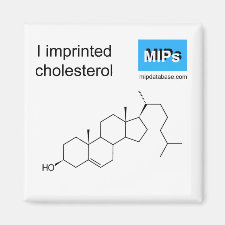
Authors: Soares CMF, Zanin GM, de Moraes FF, dos Santos OAA, de Castro HF
Article Title: Molecular imprinting of β-cyclodextrin/cholesterol template into a silica polymer for cholesterol separation.
Publication date: 2007
Journal: Journal of Inclusion Phenomena and Macrocyclic Chemistry
Volume: 57
Issue: (1)
Page numbers: 79-82.
DOI: 10.1007/s10847-006-9218-7
Abstract: The molecular assembly formed by the inclusion complex of cholesterol in β-cyclodextrin (β-CD:chol) was used as a template for the molecular imprinting of a sol-gel polymer (MIP/β-CD:chol), produced with tetraethoxysilane (TEOS) as precursor. The MIP/β-CD, produced with tetraethoxysilane (TEOS) as precursor. The MIP/β-CD:chol and pure silica matrix (PSM) were tested for the efficiency of cholesterol removal from solutions at different cholesterol concentrations (1-10 mg/mL). The adsorption tests were run at 25°C using 1% (w/v) solid/liquid suspensions during 24 h. The MIP/β-CD:chol data on cholesterol adsorption was fitted by the Langmüir isotherm model, giving a maximum adsorption capacity of 76.5 mg cholesterol/g-adsorbent. The PSM data did conform to the Langmüir model. The maximum cholesterol adsorption achieved with the PSM was higher, 251 mg/g, probably due to multilayer adsorption. The hydrophobic silica matrix, imprinted with the inclusion complex of β-CD and a target molecule, has the potential of being used as an adsorbent for other organic molecules.
Template and target information: cholesterol
Author keywords: adsorption, cholesterol, molecular imprinting, silica, sol-gel, Tetraethoxysilane, β-cyclodextrin



Join the Society for Molecular Imprinting

New items RSS feed
Sign-up for e-mail updates:
Choose between receiving an occasional newsletter or more frequent e-mail alerts.
Click here to go to the sign-up page.
Is your name elemental or peptidic? Enter your name and find out by clicking either of the buttons below!
Other products you may like:
 MIPdatabase
MIPdatabase









